Cynnwys
- Main points
- Overview
- Your views matter
- UK Gross Domestic Expenditure on R&D performed in the UK, 2013
- Expenditure on R&D performed in the UK
- Civil and defence expenditure, by performing sector
- R&D expenditure by funding sector
- Civil and defence R&D expenditure by funding sector
- Country and regional breakdown of UK R&D expenditure
- International comparisons of GERD as a percentage of GDP (R&D Intensity)
- Background notes
- Methodoleg
1. Main points
In 2013, the gross domestic expenditure on research and development performed in the UK (GERD), in current prices, increased by 7% to £28.9 billion compared with 2012. Adjusted for inflation, in constant prices, research and development (R&D) expenditure increased by 5%.
In constant prices, R&D expenditure has increased by 54% from the 1985 estimate of £18.8 billion. Expenditure has reached an all time high of £28.9 billion in 2013.
The business sector performed 64% of UK R&D expenditure in 2013. Expenditure by this sector increased by 8%, in current prices, to £18.4 billion in 2013, compared with 2012.
Total R&D expenditure in the UK in 2013 represented 1.67% of Gross Domestic Product (GDP), an increase from 1.62 % in 2012.
International comparisons show that UK R&D expenditure in 2013 was below the European Union (EU-28) provisional estimate of 2.02% of GDP, but the 12th highest of all member countries.
2. Overview
This statistical bulletin provides estimates of R&D performed in and funded by the following four sectors of the economy, as defined in the ‘Frascati Manual’:
Business Enterprise (BERD)
Higher Education (HERD)
Government (GovERD), which includes Research Councils
Private Non-Profit (PNP) organisations
All these sectors’ R&D data are known collectively as GERD, which represents the gross domestic expenditure on R&D in the UK.
GERD is unique in providing this information, and is the preferred measure of R&D activity for use in international comparisons. This release reports on R&D expenditure in the UK irrespective of the country of residence of the ultimate owner or users of the R&D produced. The main purpose of collecting R&D data from all sectors of the economy is to supply data for policy and monitoring purposes on science and technology, of which R&D is an important part.
In this statistical bulletin, R&D and related concepts follow internationally agreed standards defined by the Organisation for Economic Cooperation and Development (OECD), as published in the ‘Frascati Manual’. This manual defines R&D as “creative work undertaken on a systematic basis in order to increase the stock of knowledge, including knowledge of man, culture and society and the use of this stock of knowledge to devise new applications”.
The Frascati Manual was originally written by, and for, the experts in OECD member countries that collect and publish national data on R&D. The definitions provided in this manual are internationally accepted and serve as a common language for designing and evaluating science and technology policy.
In this statistical bulletin, R&D is measured by the expenditure on R&D performed, by an organisation, or the funding received by an organisation for R&D work. These are often but not always the same. R&D performed is regarded as a more accurate measure than funding received by an organisation, as not all funds received may be used on R&D as intended. ONS surveys therefore measure expenditure on R&D performed by four sectors of the economy, and how this expenditure is funded.
The business sector estimates in this release, the largest component of GERD, are derived from the Business Enterprise Research and Development (BERD) survey, published on 20 November 2014 in the Business Enterprise Research and Development 2013 statistical bulletin. Approximately 5,400 UK businesses were selected for this survey from a continually updated register of R&D performers.
The National Accounts provide the framework that is used to define and measure the UK’s economic performance, such as the value of the UK’s Gross Domestic Product (GDP). Changes to the European System of Accounts (ESA) meant that from September 2014 onwards, expenditure on R&D contributed to the formation of assets and therefore the value of the UK economy. Further information about this important change can be found at ONS ESA 2010.
Two types of estimates are presented in this release, current and constant prices. Estimates in current prices present the value of R&D expenditure in cash terms. Constant price estimates have been adjusted for inflation between years using the GDP deflator. This allows changes in the volume of R&D expenditures to be examined on a comparable basis over time.
For more information about what is research and development, please visit ONS podcast.
Nôl i'r tabl cynnwys3. Your views matter
We are constantly aiming to improve this release and its associated commentary. We would welcome any feedback you might have, and would be particularly interested in knowing how you make use of these data to inform your work. Please contact us via email: RandD@ons.gov.uk or telephone Cecil Prescott on +44 (0)1633 456767.
Nôl i'r tabl cynnwys4. UK Gross Domestic Expenditure on R&D performed in the UK, 2013
In 2013, £28.9 billion was spent on R&D performed within the UK, an increase in current prices of £1.9 billion (7%) since 2012. This is mainly due to a £1.3 billion increase in R&D performed by the business sector. Adjusted for inflation, in constant prices, R&D expenditure increased by 5%.
In 1985, in constant prices, £18.8 billion was spent on R&D performed in the UK. Since then, there has been an increase of 54% in R&D expenditure in the UK. Expenditure has reached an all time high of £28.9 billion in 2013 (Figure 1).
Figure 1: UK Gross Domestic Expenditure on R&D, 1985 to 2013
Source: Office for National Statistics
Download this chart Figure 1: UK Gross Domestic Expenditure on R&D, 1985 to 2013
Image .csv .xlsFigure 2 shows UK gross domestic expenditure on R&D performed in the UK, as a percentage of GDP. Total R&D expenditure in 2013 represented 1.67% of GDP, an increase on the 1.62% estimate for 2012. Following the upward revisions to GDP as a result of the implementation of the changes to the National Accounts, the ratio of GERD to GDP has been revised down slightly over the period 1985 to 2012.
UK gross domestic R&D expenditure, as a percentage of GDP, peaked in 1986 at 2.03%. Since 2001, R&D expenditure as a percentage of GDP has been within a range of 1.59% to 1.73%.
Figure 2: UK gross expenditure on R&D as a percentage of GDP, 1985 to 2013
Source: Office for National Statistics
Download this chart Figure 2: UK gross expenditure on R&D as a percentage of GDP, 1985 to 2013
Image .csv .xls5. Expenditure on R&D performed in the UK
UK estimates of R&D cover the four sectors of the economy, namely Business, Higher Education, Government (including Research Councils), and Private Non-Profit organisations. Figure 3 shows the contribution each sector made to the total UK R&D expenditure estimate in 2013.
Figure 3: Composition of UK GERD by performing sector, 2013
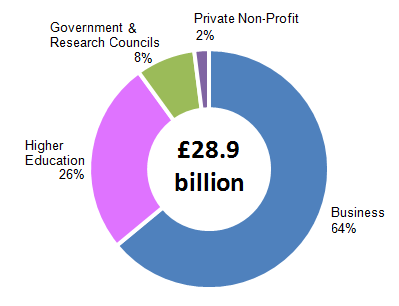
Source: Office for National Statistics
Download this image Figure 3: Composition of UK GERD by performing sector, 2013
.png (10.6 kB) .xls (26.1 kB)Taking each of these R&D sectors in turn:
Business
The business sector performs the most R&D of any sector in the UK. In 2013 it accounted for £18.4 billion of expenditure, representing 64% of total expenditure on R&D performed in the UK. This is an increase of 8% in current prices from £17.1 billion in 2012.
On an annual basis, the 400 largest business R&D performers are asked to select the industry product groups that best describe the type of R&D that they undertake. For the smaller R&D performers, no product group data were collected (Background Note 4). The product groups with the largest R&D expenditure in 2013 (Figure 4) were:
Pharmaceuticals (£4.1 billion)
Motor vehicles and parts (£2.1 billion)
Computer programming and information service activities (£2.0 billion)
Aerospace (£1.7 billion)
Machinery and equipment (£1.0 billion)
Miscellaneous business activities (£1.0 billion)
The UK Government has continued to promote growth in R&D, particularly in the business sector, through tax relief, and Catapult centres. A Catapult is a “technology and innovation centre where UK businesses, scientists and engineers can work together on research and development, transforming ideas into new products and services”.
Figure 4: Business sector expenditure on R&D performed in the UK, by R&D product group, 2013
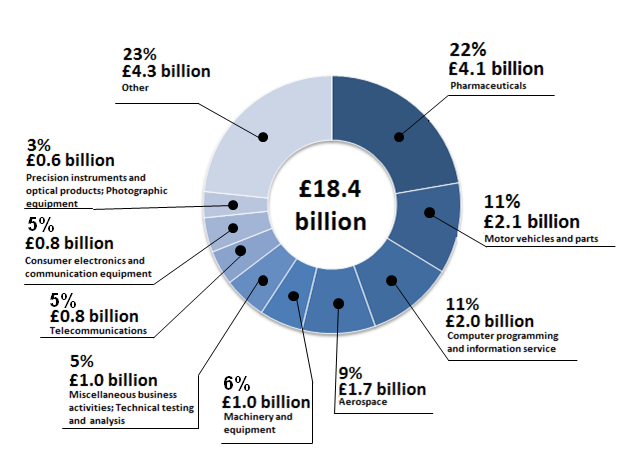
Source: Office for National Statistics
Download this image Figure 4: Business sector expenditure on R&D performed in the UK, by R&D product group, 2013
.png (120.5 kB) .xls (27.1 kB)More detailed information on business R&D expenditure can be found in the UK Business Enterprise Research and Development 2013 statistical bulletin published on 20 November 2014.
Higher education
The higher education sector, which includes universities and higher education institutes, represented 26% of total UK R&D expenditure in 2013 at £7.6 billion. This is an increase of 6% in current prices from £7.2 billion in 2012. The funding for this sector is mainly provided by the Higher Education Funding Councils for England, Scotland and Wales, the Department for Education in Northern Ireland and the seven UK research councils.
Government and research councils
The UK Government owns many research institutes and laboratories that carry out R&D. These are managed by different government departments, including the Department for Business, Innovation and Skills, the Department for Environment, Food and Rural Affairs and the Department of Health.
In 2013, R&D expenditure in the UK performed by the government and research councils sector increased by 7% in current prices, from £2.1 billion in 2012 to £2.3 billion in 2013. This sector accounted for 8% of total expenditure on R&D performed in the UK in 2013.
Research Councils UK (RCUK) is the strategic partnership of the UK's seven research councils. Each year the councils perform research covering the full spectrum of academic disciplines from the medical and biological sciences to the arts and humanities.
Research councils’ R&D expenditure increased by 1% in current prices, from £804 million in 2012 to £813 million in 2013.
Private non-profit organisations
The private non-profit sector includes registered charities and trusts. Those performing R&D specialise in mainly health and medical research. Some of the largest of these are based in the UK. This sector includes, for example, a number of cancer charities that carry out extensive research into types of cancer prevention, from drug development to clinical trials.
The private non-profit sector is the smallest R&D performing sector in the UK. In 2013, it is estimated that expenditure on R&D performed by these organisations was £0.5 billion, which contributed 2% to total UK R&D expenditure.
Nôl i'r tabl cynnwys6. Civil and defence expenditure, by performing sector
Expenditure on R&D, performed for civil purposes in 2013 (£27.0 billion) accounted for 93% of total UK R&D expenditure (Figure 5).
In current prices, civil R&D expenditure increased by 7%, from £25.2 billion in 2012 to £27.0 billion in 2013. Defence R&D expenditure also increased by 7%, from £1.8 billion in 2012 to £1.9 billion in 2013.
In constant prices, civil R&D expenditure has increased by 71% (£11.2 billion) since the 1989 estimate of £15.8 billion. In contrast, defence R&D expenditure has decreased by 61% over the same period, from £5.0 billion in 1989.
Figure 5: Expenditure on civil and defence R&D performed in the UK, 1989 to 2013
Source: Office for National Statistics
Download this chart Figure 5: Expenditure on civil and defence R&D performed in the UK, 1989 to 2013
Image .csv .xlsCivil and defence R&D expenditure can be further split between the four performing UK sectors. The business sector was by far the largest R&D performer in both civil and defence R&D in 2013, at £16.7 billion and £1.7 billion respectively.
Of particular note, business R&D expenditure in the civil sector has increased by 54% in constant prices since 1989, but business expenditure on R&D in the defence sector has decreased by 47% over this period.
Nôl i'r tabl cynnwys7. R&D expenditure by funding sector
In 2013, the largest funder of R&D performed in the UK was the business sector which funded £13.3 billion; 46% of the total UK performed R&D. This was an increase of 8%, in current prices, from £12.3 billion in 2012 (Figure 6).
Although the government and research councils sector spent £2.3 billion performing R&D within their UK public research institutes, they actually funded £6.1 billion of UK R&D spend, 21% of total funding. This can be understood through the role of RCUK which offers individuals and businesses overseas, access to the UK’s research facilities and infrastructure.
In just under three decades, there has been a change in the profile of how UK R&D expenditure has been funded. In 1985, 8% of R&D funding came from overseas. Since then, there has been a steady increase in the proportion of funding for UK R&D expenditure from overseas, from 16% in 1996 to 19% in 2013.
Figure 6: Composition of UK GERD by funding sector, 1996 to 2013
Source: Office for National Statistics
Download this chart Figure 6: Composition of UK GERD by funding sector, 1996 to 2013
Image .csv .xlsFigure 7 is a representation of the flows of R&D funding from the four UK sectors and overseas. The values in the boxes are the amounts of funding that each individual sector provided to the other sectors in the UK in 2013. The arrows indicate the values provided to the recipient sector.
It is important to note that sectors can fund themselves. For example, in 2013 the business sector performed £18.4 billion, of which £12.8 billion was funded by this sector. The remaining £5.7 billion of R&D expenditure performed by the business sector was funded by other sectors and overseas.
Figure 7: Flows of R&D funding in the UK, 2013
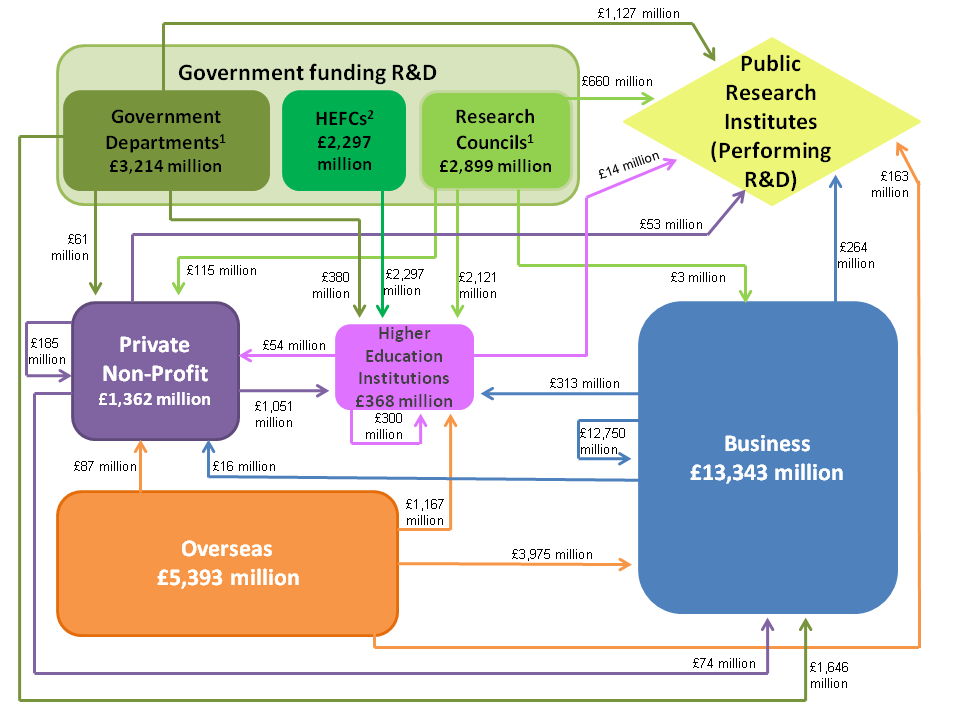
Source: Office for National Statistics
Notes:
- For full information see Table 1 from the data section of this publication. Please note, that government departments and research councils carry out their R&D in public research institutes, so their flows of funds are combined in Figure 7.
- HEFCs – Higher Education Funding Councils.
Download this image Figure 7: Flows of R&D funding in the UK, 2013
.png (51.9 kB) .xls (28.7 kB)8. Civil and defence R&D expenditure by funding sector
The largest funder of civil R&D performed in the UK was the business sector (£12.9 billion), 48% of total civil funding.
Of the £5.4 billion funding received from overseas in 2013, 97% was performed on civil R&D (£5.2 billion).
R&D expenditure in the UK for defence purposes accounted for 7% of total R&D expenditure (£1.9 billion) in 2013. The UK Government’s funding of defence R&D in 2013 was £1.3 billion (67% of total defence funding). This was an increase of 7% in current prices from £1.2 billion in 2012. This includes government contracts awarded to UK businesses for the development of aircraft, naval ships, submarines and their systems and equipment. The business sector provided £0.5 billion (24%) of funding and £0.2 billion (9%) came from overseas.
Nôl i'r tabl cynnwys9. Country and regional breakdown of UK R&D expenditure
R&D expenditure can be analysed by UK country and region (Figure 8). In this context, the country and region refers to the location where the R&D is performed, not the location of the funder.
In 2013, the South East and East of England continued to dominate R&D activity in the UK. These two regions accounted for 40% of total UK R&D expenditure (£11.4 billion).
The majority of UK R&D expenditure was carried out in England (£25.5 billion) in 2013, an increase of 7% in current prices from £23.9 billion in 2012. Wales, Scotland and Northern Ireland showed increases of 22%, 8% and 6% respectively in 2013.
Figure 8: UK GERD by sector, country and region, 2013
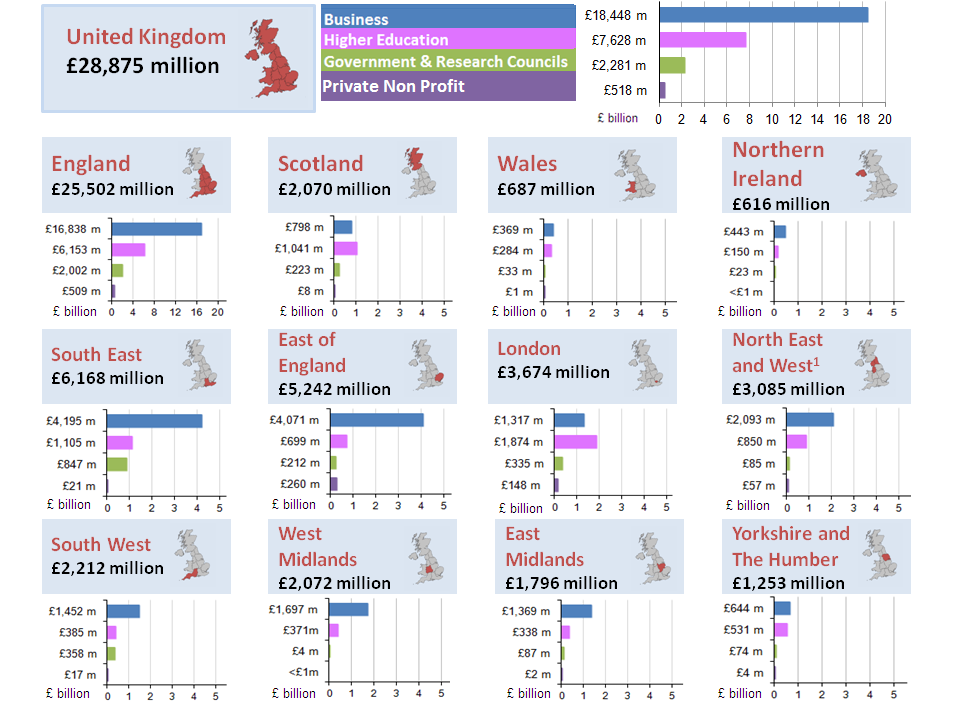
Source: Office for National Statistics
Notes:
- North East and North West regions data have been combined due to confidentiality.
Download this image Figure 8: UK GERD by sector, country and region, 2013
.png (158.5 kB) .xls (31.7 kB)10. International comparisons of GERD as a percentage of GDP (R&D Intensity)
The Europe 2020 targets specify five targets for the European Union (EU) to achieve by 2020, including a target of 3% of the EU’s GDP to be invested in R&D. This means that the estimates in this release are essential in monitoring progress towards this target.
The percentage of R&D to GDP increased marginally in the EU-28 up to 2002, reaching a high of 1.81%, before declining modestly through to 2005 (1.76%), and climbing again to an estimated 2.02% in 2013. Please note that some EU-28 and OECD countries' 2013 estimates taken from the Eurostat website are provisional estimates at the time of this release.
Map: GERD to GDP ratio as a percentage (R&D intensity) by country, European Union (EU-28), 2013
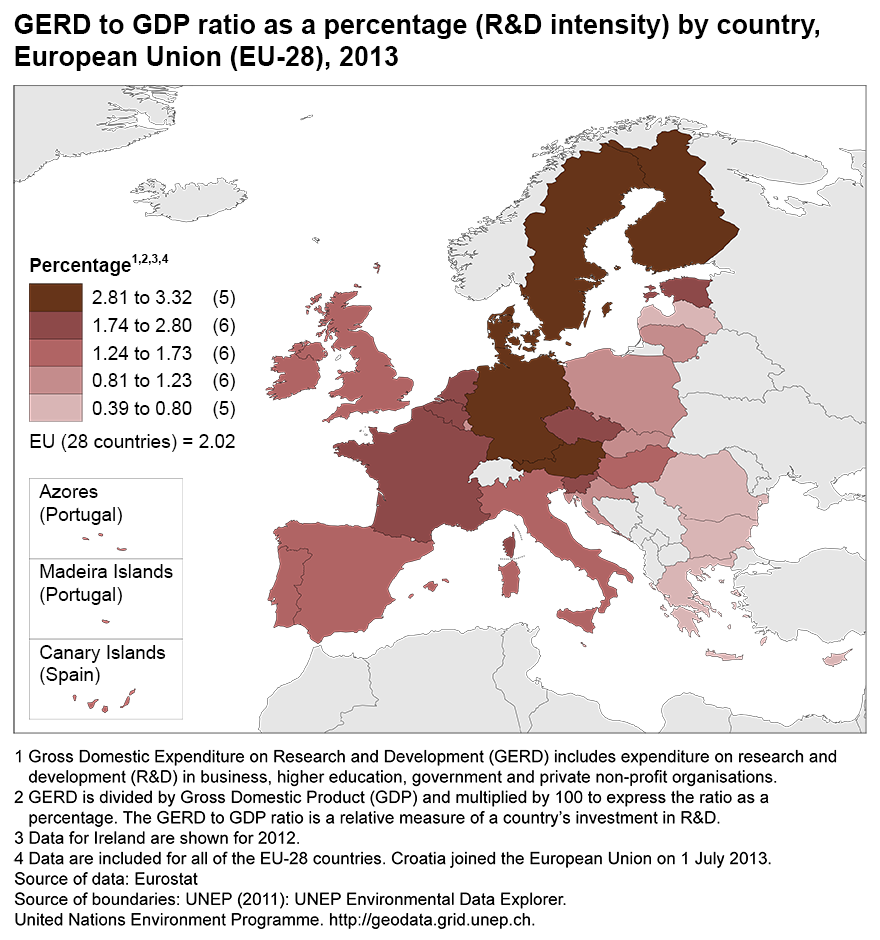
Source: Eurostat
Download this image Map: GERD to GDP ratio as a percentage (R&D intensity) by country, European Union (EU-28), 2013
.png (333.6 kB)Figure 9 presents the latest available 2013 estimates as a means of placing the UK into an international context with regards to GERD as a percentage of GDP. It shows the individual EU-28 countries’ GERD as a percentage of GDP, as well as the average for the EU-28, compared with the Europe 2020 target of 3%. The UK’s GERD represented 1.67% of GDP in 2013, an increase from 1.62 % in 2012, the 12th highest percentage.
Figure 9: EU countries GERD as a percentage of GDP (R&D intensity), 2013
Source: Eurostat
Notes:
- * indicates data for Ireland is 2012.
- Some EU countries' 2013 estimates taken from the Eurostat website are provisional.
- Europe 2020 target = 3%.
Download this chart Figure 9: EU countries GERD as a percentage of GDP (R&D intensity), 2013
Image .csv .xlsThe latest OECD estimates of GERD indicate that the modest increase in the EU GERD as a percentage of GDP that began in 2011 continued into 2013. The OECD’s own preliminary estimates indicate an overall increase in GERD as a percentage of GDP from 1.97% in 2011 to 2.02% in 2013.
When comparing total business R&D intensity across countries, it is important to take into account differences in individual countries industrial structures. The OECD has produced a Science, Technology and Industry Scoreboard to help facilitate these comparisons.
Nôl i'r tabl cynnwys
